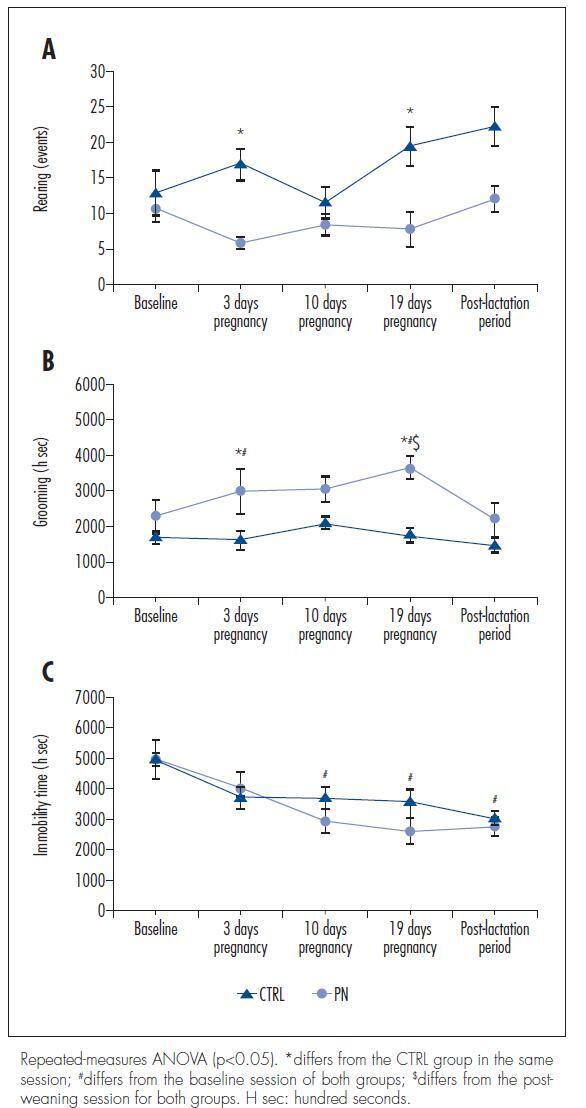-
Original Article10-03-2014
Changes in motor behavior during pregnancy in rats: the basis for a possible animal model of restless legs syndrome
Revista Brasileira de Ginecologia e Obstetrícia. 2014;36(10):436-441
Abstract
Original ArticleChanges in motor behavior during pregnancy in rats: the basis for a possible animal model of restless legs syndrome
Revista Brasileira de Ginecologia e Obstetrícia. 2014;36(10):436-441
DOI 10.1590/SO100-720320140005105
Views80See morePURPOSE:
Pregnant women have a 2-3 fold higher probability of developing restless legs syndrome (RLS – sleep-related movement disorders) than general population. This study aims to evaluate the behavior and locomotion of rats during pregnancy in order to verify if part of these animals exhibit some RLS-like features.
METHODS:
We used 14 female 80-day-old Wistar rats that weighed between 200 and 250 g. The rats were distributed into control (CTRL) and pregnant (PN) groups. After a baseline evaluation of their behavior and locomotor activity in an open-field environment, the PN group was inducted into pregnancy, and their behavior and locomotor activity were evaluated on days 3, 10 and 19 of pregnancy and in the post-lactation period in parallel with the CTRL group. The serum iron and transferrin levels in the CTRL and PN groups were analyzed in blood collected after euthanasia by decapitation.
RESULTS:
There were no significant differences in the total ambulation, grooming events, fecal boli or urine pools between the CTRL and PN groups. However, the PN group exhibited fewer rearing events, increased grooming time and reduced immobilization time than the CTRL group (ANOVA, p<0.05).
CONCLUSION:
These results suggest that pregnant rats show behavioral and locomotor alterations similar to those observed in animal models of RLS, demonstrating to be a possible animal model of this sleep disorder.

-
Original Article04-13-2005
Sleep disturbance prevalence in postmenopausal women
Revista Brasileira de Ginecologia e Obstetrícia. 2005;27(12):731-736
Abstract
Original ArticleSleep disturbance prevalence in postmenopausal women
Revista Brasileira de Ginecologia e Obstetrícia. 2005;27(12):731-736
DOI 10.1590/S0100-72032005001200005
Views141PURPOSE: to evaluate the prevalence of reported sleep disturbances through polysomnographic recording (PSG) in a sample of postmenopausal women. METHODS: thirty-three postmenopausal women with a mean age of 56 years, a mean body mass index (BMI) of 27 kg/m², with 7.7 years of recognized postmenopausal period, and a mean Kupperman index of 17, were selected. The inclusion criteria were: age range from 50 to 65 years, at least one year of amenorrhea and an FSH which equaled or exceeded 30 mU/ml; they should not be undergoing hormone therapy, and should display normal laboratory test results. The patients with severe clinical diseases and/or decompensated were excluded; also the ones with suspicion of carcinoma of endometrium and/or breast cancer, a BMI over 30 kg/m² and those who ingested hypnotic drugs. The patients followed a routine climacteric check-up, answered a questionnaire about sleep and underwent an all-night PSG recording. Frequencies in percentage of emerging sleep complaints based on the questionnaire and those pertaining to PSG diagnosis were then calculated separately. RESULTS: the subjective prevalence of insomnia was 61% against 83% in the PSG recordings. The prevalence of apnea reported was 23% against 27% in the PSG. The subjective restless legs syndrome prevalence was 45%, and the objective, 27%. CONCLUSION: there was a high prevalence of sleep disturbances in postmenopausal patients, specially insomnia, apnea and restless legs.
Key-words PolysomnographyPostmenopauseRestless legs syndromeSleep apnea syndromesSleep disorderSleep iniciation and maintenance disordersSee more


